This guide comprehensively lists all the local government areas in Edo state and their chairman. Edo State, located in the South-South region of Nigeria, is known as the “Heart Beat of the Nation.”
Created in 1991 from the former Bendel State, its capital is Benin City, Nigeria’s fourth-largest city and a hub for the rubber industry.
With a population of about 5.25 million in 2024, Edo is Nigeria’s 22nd most populous state. It was once home to the Benin Empire, famous for its ancient earthworks. The state is culturally diverse, with Edoid people like the Edo, Esan, and Afemai.
READ ALSO: Complete List Of Anambra State Local Government Areas And Their Chairmen
List Of Edo State Local Government Areas And Their Chairmen
Edo State has 18 Local Government Areas (LGAs), each with its respective chairman:
-
- Akoko-Edo – Mr. Tajudeen Sulaiman
- Egor – Eghe Ogbemudia
- Esan Central – Kelvin Iyere
- Esan North-East – Paul Akhere Uhomesili
- Esan South-East – Louis Imhandegbelo
- Esan West – Hon. Collins Aigbogun
- Etsako Central – Hon. Solomon Imokhai Obomighie
- Etsako East – Hon. Benedicta Attoh
- Etsako West – Hon. Zibiri Muhizu Marvelous
- Igueben – Hon. Dr. Josie Ogedegbe
- Ikpoba-Okha – Dr. Eric Osayande
- Oredo – Dr. Tom Obaseki
- Orhionmwon – Hon. Newman Oghomwen Ugiagbe
- Ovia North-East – Mr. Collins Ogbewe
- Ovia South-West – Engr. Edosa Enowoghomwenma
- Owan East – Hon. Andrew Osigwe
- Owan West – Mr. Frank Ilaboya
- Uhunmwonde – Hon. Adodo Kenneth Osarobo
READ ALSO: Local Government Areas In Kwara State And Their Chairmen
Which LGA Is The Biggest In Edo State?
The largest Local Government Area (LGA) in Edo State is Orhionmwon. This LGA is located in the southern part of the state, with its headquarters in Abudu.
It covers an area of 2,382 square kilometers, making it the largest LGA by land mass not only in Edo South Senatorial District but also in the entire state.
According to the 2006 census, Orhionmwon had a population of 206,717 people. Orhionmwon is rich in natural resources and has the largest gas deposit in Nigeria, which might also be the largest in West Africa.
The area is also home to rubber and palm plantations and several agricultural products, such as yams, cassava, plantains, and maize.
These contribute to its thriving agricultural industry. The Urhonigbe Rubber Plantation and Sokponba Resort are notable places within the LGA, along with other landmarks like oil palm factories.
Economically, Orhionmwon is active in trading, with many markets attracting buyers and sellers of various goods. Other notable economic activities include food processing, logging, and animal farming.
These provide livelihoods to the people in the region. However, the LGA is made up of many towns and villages, including Abudu, Urhonigbe, Igbanke, Ugo, Oben, and many others.
Most of the residents belong to Benin-speaking communities and share a rich cultural heritage. Neighboring Delta, Kogi, and Ondo States border the local government.
READ ALSO: Complete List Of Benue State Local Government Areas and Their Chairmen
Which Local Government Area Is The Most Populated In Edo State?
Oredo Local Government Area is the most populated area in Edo State, Nigeria. It is located in the southern part of the state and includes Benin City, the state capital. It has an area of about 249 square kilometers.
The people of Oredo are mainly from the Bini ethnic group, which is known for its traditional music, colorful festivals, and historical importance.
Many other ethnic groups also live in Oredo. As of the 2006 census, the population of Oredo was about 374,671 people.
By 2022, estimates showed the population had grown to around 553,300. The area has a youthful population, with many people under the age of 15.
Also, the gender distribution in Oredo is fairly balanced, with a slightly higher number of males compared to females.
Oredo’s economy is driven by trade and commerce, which thrive due to its location in Benin City. The area has many small and medium-sized businesses, and its markets are busy with activities.
Some people also work in agriculture, growing and trading crops for food and income. The infrastructure in Oredo has improved over the years, with better roads for easier transportation.
There are schools and healthcare facilities, but more efforts are needed to improve accessibility and the quality of services.



